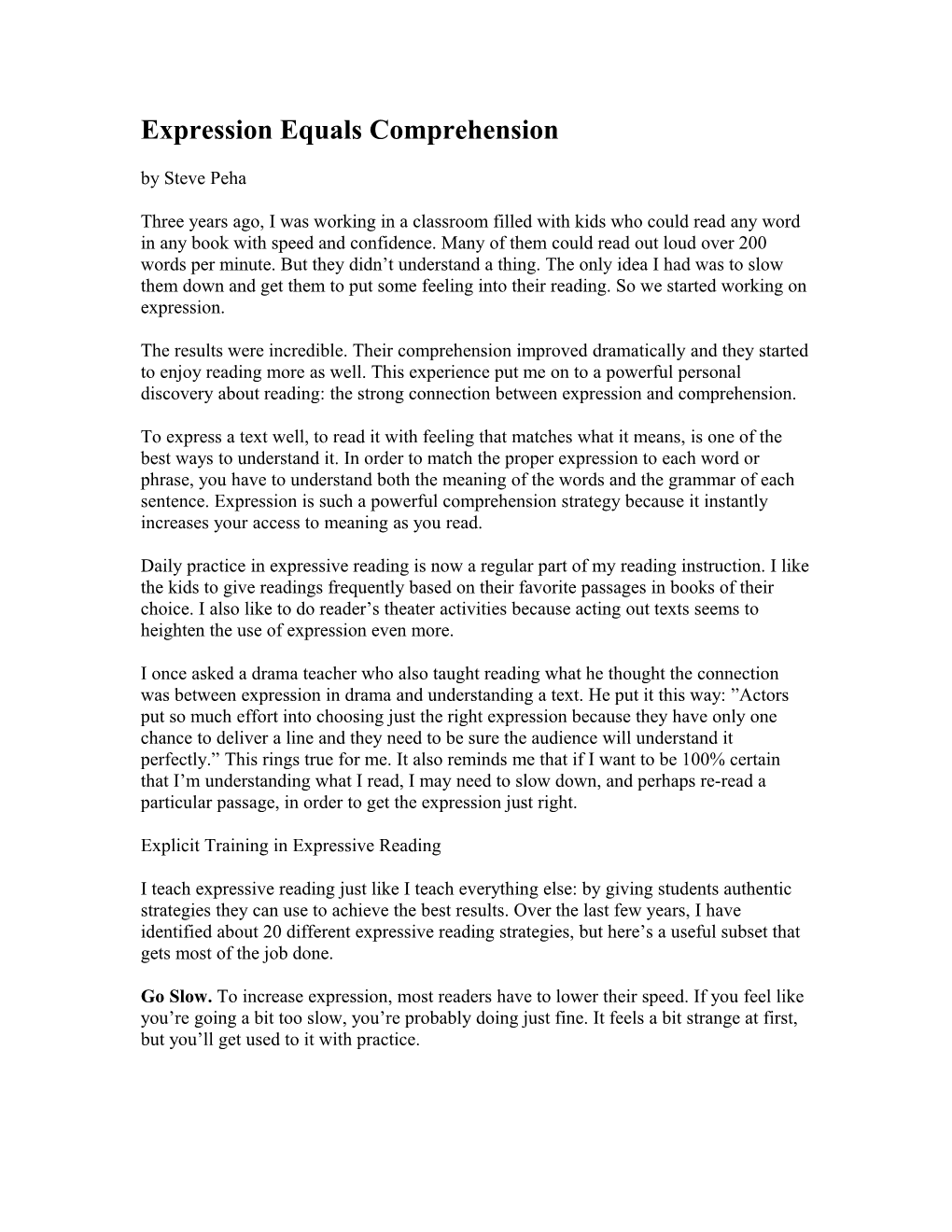Expression Equals Comprehension
by Steve Peha
Three years ago, I was working in a classroom filled with kids who could read any word in any book with speed and confidence. Many of them could read out loud over 200 words per minute. But they didn’t understand a thing. The only idea I had was to slow them down and get them to put some feeling into their reading. So we started working on expression.
The results were incredible. Their comprehension improved dramatically and they started to enjoy reading more as well. This experience put me on to a powerful personal discovery about reading: the strong connection between expression and comprehension.
To express a text well, to read it with feeling that matches what it means, is one of the best ways to understand it. In order to match the proper expression to each word or phrase, you have to understand both the meaning of the words and the grammar of each sentence. Expression is such a powerful comprehension strategy because it instantly increases your access to meaning as you read.
Daily practice in expressive reading is now a regular part of my reading instruction. I like the kids to give readings frequently based on their favorite passages in books of their choice. I also like to do reader’s theater activities because acting out texts seems to heighten the use of expression even more.
I once asked a drama teacher who also taught reading what he thought the connection was between expression in drama and understanding a text. He put it this way: ”Actors put so much effort into choosing just the right expression because they have only one chance to deliver a line and they need to be sure the audience will understand it perfectly.” This rings true for me. It also reminds me that if I want to be 100% certain that I’m understanding what I read, I may need to slow down, and perhaps re-read a particular passage, in order to get the expression just right.
Explicit Training in Expressive Reading
I teach expressive reading just like I teach everything else: by giving students authentic strategies they can use to achieve the best results. Over the last few years, I have identified about 20 different expressive reading strategies, but here’s a useful subset that gets most of the job done.
Go Slow. To increase expression, most readers have to lower their speed. If you feel like you’re going a bit too slow, you’re probably doing just fine. It feels a bit strange at first, but you’ll get used to it with practice.
Repeat Till It’s Complete. If you mess up, don’t go on, go back and repeat the sentence from the very beginning. If you keep messing up, take a moment to practice the word or phrase you’re having trouble with, then try again.
Sentence High and Low. Start a bit higher in pitch at the beginning of a sentence then, as you approach the end, gradually lower the pitch of your voice.
Sentence Fast and Slow. Start out at a good clip but taper off your speed just slightly as you near the end. This one should be very subtle, don’t over do it.
Up at the End for a Question Mark. The pitch of your voice should go up at the end of a question.
Straight Up for an Exclamation Mark. Shoot your voice straight up in both pitch and volume if you see an exclamation mark.
Big Pause at a Period, Small Pause at a Comma. Pay attention to punctuation. Treat colons, semi-colons, and dashes just like commas.
Character High, Narrator Low. In passages that contain dialog, raise the pitch of your voice for spoken parts (the dialog), lower the pitch for attributions (the "He saids and She saids) and other text by the narrator.
Emphasize the Important Word. Pick one key word in a sentence and call attention to it by raising the volume of your voice, changing tone, or stretching it out to make it last just a bit longer than normal. This strategy should also be used very subtly.
Moving Ahead to Advanced Expressive Reading
This is the set of strategies I use to get kids started with expressive reading. If I work on these for a while, maybe a week or two, until thekids really get them down, I usually see great improvement in expression and comprehension from virtually everyone. Once you get the hang of it, you’ll be ready for more advanced techniques which I’ll be covering next.
Getting Started
I introduce the strategies through choral reading practice. I make sure everyone has the same text, usually a work of fiction that I know most students can read fairly easily. Then I model the strategies one at a time and we all practice them together chorally until we’re ready to try them individually.
